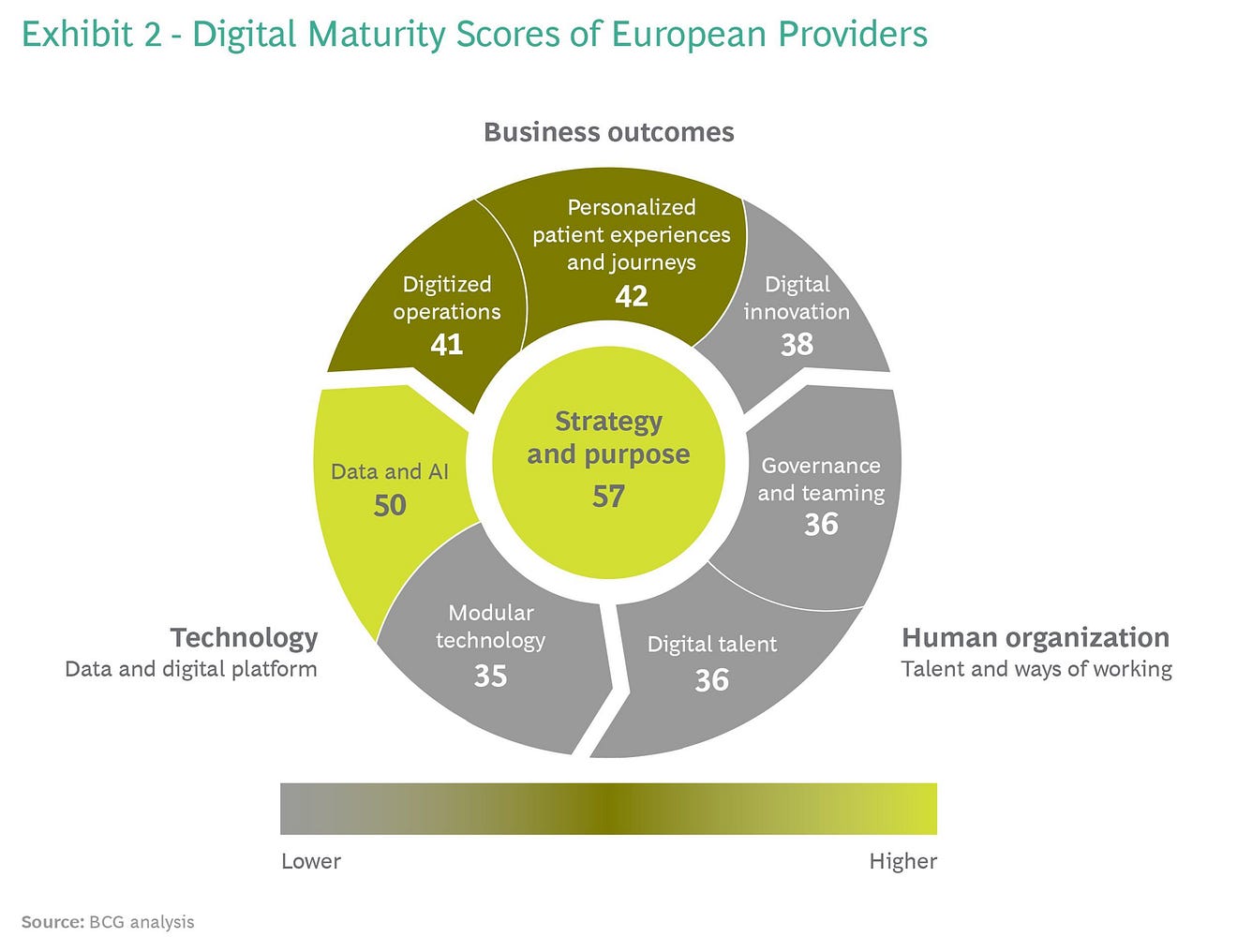This is an excerpt from the paper “Health Care Providers in Europe Need to Boost Digital Momentum” , edited by Joaquim Cardoso
BCG — Boston Consulting Group
By Ben Horner, Adina Symreng, Stefano Cazzaniga, Jennifer Clawson, Jaap Schreurs, India Miller, and John Gooch
JUNE 17, 2021
Health Care Struggles with Digital Maturity
The benchmark survey of European providers was based on BCG’s Digital Acceleration Index, which surveyed over 2,300 companies in ten industries across the world.
Globally, health care scored low on the digital maturity index-eighth place out of nine industries. And, it turns out, European health care providers are low performers among their global peers.
Our benchmark survey-based on self-assessments by each provider of its strategy and outcomes, as well as the enabling technology and human organization-found that
- all health care organizations globally scored 52 out of 100,
- US health care providers scored 48, and
- European providers scored 44. (See “Methodology.”)
We identified four key reasons for low digital maturity.
- Failure to Make Digital a Priority
- Challenges in Translating Strategy into Impact
- Lack of Investment in Digital Talent
- External Barriers to Digital Transformation
1.Failure to Make Digital a Priority
While many providers recognize the importance of digital tools to improve their care and efficiency, most do not see them as fundamental to normal clinical and administrative operations. Just 25% of respondents are focusing on digitizing back-office operations, and just 38% focus on digital and data in clinical research innovation.
In the words of one respondent: “Digital and data analytics are seen as ‘things’ that need to be delivered, rather than a key component of everything we deliver.” Another noted that because many providers need to achieve “in-year” benefits, it’s difficult to plan for multiyear digital transformations.
Not surprisingly, many providers have low digital ambitions, with a third saying they do not even aspire to be digital leaders. One said that end-to-end customer journeys “is not a digital area but rather a cultural and strategic area. Digitization is not our main focus toward this.”
Moreover, the attitudes of leaders and clinicians remain very conservative. Indeed, CIOs told us that one of the biggest barriers to digital transformation they face is bringing management on board and getting leaders to prioritize these efforts. This is in stark contrast to the US, where many CEOs are personally sponsoring digital transformations.
2.Challenges in Translating Strategy into Impact
Many providers have digital strategies in place but struggle to translate them into business outcomes. (See Exhibit 2.) New digital tools often run on legacy infrastructure, which makes it difficult to gather, analyze, and integrate findings into decision-making. One respondent said: “We collect the data, we analyze the data, but we are not good in creating value out of our data.” Another said that “patient outcomes are measured, but they are not used enough in strategic decision-making.”

Another reason for their struggle to translate strategies into impact is that providers often focus on their own isolated digital initiatives and don’t coordinate with other local provider organizations. This impedes the building of joint governance structures, clinician buy-in, broad standardization, and the ability to create a seamless patient journey. “We need to evolve towards a model of interoperability that ensures the exchange of information without constraints on implementations, avoiding ad hoc integrations,” said one respondent. Another added: “We handle a rather limited slice of the pie for a given patient condition, and although we can measure the costs and hard outcomes for the slice [we are far from being] able to measure it for the whole patient journey.”
3.Lack of Investment in Digital Talent
European health leaders are not putting a premium on recruiting digital talent, and they are not investing enough to train their employees. Our survey found that European providers are performing poorly on almost all the human elements of digital maturity.
When we asked, “Are you a leader in attracting and hiring digital talent and creating a talent ecosystem?” providers had an average score of 40, below their overall digital maturity score of 44. When it came to ongoing training, setting learning goals, and fostering a shift from human-operated to human-designed processes, they scored an even lower 32.
The results for governance and teaming were worse still. European providers scored just 28 when asked “Does your organization have a platform of end-to-end processes…to support the objectives of front-line services?” And very few providers use a dedicated team to help accelerate the digital transformation. In other industries, these teams are more common. They take an unbiased, holistic, integrated approach to the digital transformation, report directly to senior leadership, and act as the organization’s focal point for innovation.
4.External Barriers to Digital Transformation
The three reasons described above for low digital maturity all relate to internal barriers. But there are also external barriers to contend with.
Providers need to align their digital transformations with government agencies. “The current governance and financial model of the government puts roadblocks in agile digital development,” one respondent said. Another added: “The hospital’s digital maturity is governed by the payer’s digital strategy and governance. We are dependent on their maturity to reach our goal.”
Moreover, providers can run into privacy and legal issues when trying to apply big data analytics and AI to patient data.
Another challenge has been governments’ reluctance to reimburse for therapies delivered through digital channels. Here there has been progress during the pandemic. For example, Germany raised the cap on the percentage of clinical interactions with patients that can be virtual.
What’s driving the low digital maturity of European providers is clear:
above all, it’s about people.
- While many European providers are working with cutting-edge technology and infrastructure in parts of their operations, very few are getting the full value of that investment,
- because they are not paying enough attention to human behaviors, capabilities, and ways of working.
++++++++++++++++++++++++++++++++++++++++
BOX — METHODOLOGY
For our Digital Acceleration Index (DAI), BCG asked 2,296 companies across 28 countries in Asia, Europe, and North America to estimate their digital maturity on a scale of 1 to 4 in 36 categories.
We then aggregated those raw scores and calculated the resulting values to their responses on a scale from 0 to 100.
We weighted them to determine each company’s overall performance on our DAI. For the 2021 European Provider Digital Benchmark we took a closer look at 24 providers from 10 countries, including private, public, and nonprofit institutions. The benchmark also allows comparison against previous survey results.
++++++++++++++++++++++++++++++++++++++++
About the authors
Ben Horner, Managing Director & Partner, London
Adina Symreng, Partner, Stockholm
Stefano Cazzaniga, Partner & Director, Milan
Jennifer Clawson, Partner & Associate Director, Madrid
Jaap Schreurs, Principal, AmsterdamIndia Miller, Alumna John Gooch, Managing Director & Senior Partner. London
About Boston Consulting Group
Boston Consulting Group partners with leaders in business and society to tackle their most important challenges and capture their greatest opportunities. BCG was the pioneer in business strategy when it was founded in 1963. Today, we work closely with clients to embrace a transformational approach aimed at benefiting all stakeholders-empowering organizations to grow, build sustainable competitive advantage, and drive positive societal impact.
Our diverse, global teams bring deep industry and functional expertise and a range of perspectives that question the status quo and spark change. BCG delivers solutions through leading-edge management consulting, technology and design, and corporate and digital ventures. We work in a uniquely collaborative model across the firm and throughout all levels of the client organization, fueled by the goal of helping our clients thrive and enabling them to make the world a better place.
Originally published at https://www.bcg.com on June 15, 2021.
To download the PDF, with the full version of the paper, open the URL below












